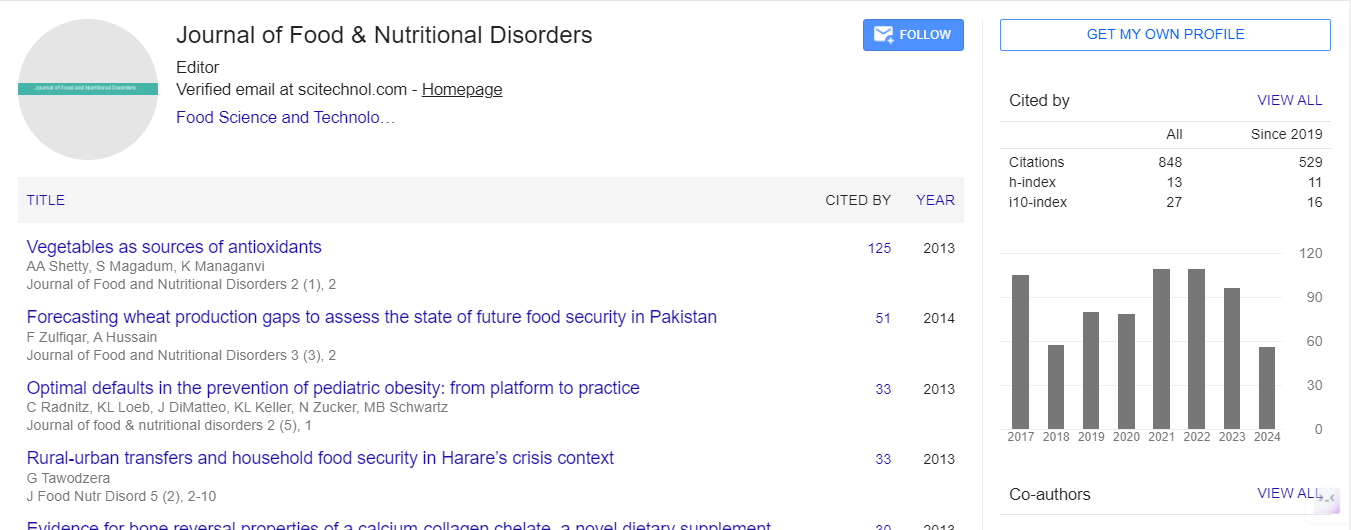Opinion Article, J Food Nutr Disor Vol: 13 Issue: 6
Ethnic Disparities in the Prevalence and Management of Food Allergies
Carlos Ruiz*
1Department of Food Science and Human Nutrition, University of Florida, Gainesville, FL, USA
*Corresponding Author: Carlos Ruiz,
Department of Food Science and Human
Nutrition, University of Florida, Gainesville, FL, USA
E-mail: ruizcarlos@yahoo.com
Received date: 25 November, 2024, Manuscript No. JFND-24-156712;
Editor assigned date: 27 November, 2024, PreQC No. JFND-24-156712 (PQ);
Reviewed date: 13 December, 2024, QC No. JFND-24-156712;
Revised date: 20 December, 2024, Manuscript No JFND-24-156712 (R);
Published date: 30 December, 2024, DOI: 10.4172/2324-9323.1000437.
Citation: Ruiz C (2024) Ethnic Disparities in the Prevalence and Management of Food Allergies. J Food Nutr Disor 13:6.
Description
Food allergies represent a significant public health concern, characterized by abnormal immune responses triggered by the consumption of certain foods. The prevalence of food allergies has risen markedly over the past few decades, affecting millions of individuals worldwide. However, research indicates that the prevalence and management of food allergies are not uniformly distributed across ethnic groups. Understanding these disparities is essential for developing effective prevention and intervention strategies tailored to diverse populations.
Epidemiological studies have revealed noteworthy differences in food allergy prevalence among various ethnic groups. In the United States, studies demonstrate that food allergies are more common among children of African and Hispanic descent compared to their Caucasian counterparts. For instance, a comprehensive study found that Black children had higher rates of peanut and shellfish allergies, while Asian children often displayed an increased sensitivity to specific allergens such as fish and milk. These findings suggest that genetic, environmental and cultural factors play a critical role in the varying prevalence of food allergies across different ethnic groups. Moreover, geographical variations in food allergies have also been observed. For example, children in urban areas, where ethnic diversity is more pronounced, show different patterns of food allergies compared to those in rural settings. These disparities may be influenced by factors such as dietary habits, exposure to environmental allergens, and genetic predispositions. Cultural practices and dietary habits are important aspects that contribute to the differences in food allergies among ethnic groups. Traditional diets often consist of a variety of foods that may not typically be consumed in Western-style diets. For instance, Asian and African cuisines frequently include ingredients such as peanuts, tree nuts, and seafood, which are common allergens. As individuals from these ethnic backgrounds migrate to regions with different dietary practices, they may encounter novel food items that could trigger allergic reactions.
Additionally, cultural attitudes toward food play a significant role in the management of food allergies. In some cultures, food allergies may not be well-recognized or may be stigmatized, leading to a lack of awareness and understanding among affected individuals and their families. This cultural stigma can prevent timely diagnosis and treatment, as families may pause to seek medical advice or may not prioritize allergy testing. There are several barriers that ethnic minorities face in managing food allergies effectively. One of the major challenges is the lack of culturally appropriate educational resources and healthcare policies. Many healthcare providers may not be adequately trained to address the needs of diverse populations, leading to miscommunication and misunderstandings regarding allergy management. Furthermore, educational materials about food allergies often do not consider cultural differences in food preparation and consumption, which can result in ineffective management strategies. Language barriers can also complicate communication between healthcare providers and patients from minority ethnic backgrounds. Limited English proficiency can hinder access to allergy education and resources, making it difficult for families to navigate food allergy management. As a result, individuals from these communities may be at higher risk of experiencing severe allergic reactions due to insufficient knowledge of food allergies and their management. To address the disparities in food allergy prevalence and management, a multi-faceted approach is necessary. First, healthcare systems should prioritize culturally competent care, ensuring that healthcare professionals are trained to understand the unique needs of diverse populations. This can include providing language support services, culturally relevant educational materials, and community outreach programs aimed at raising awareness about food allergies. Moreover, researchers should conduct more comprehensive studies investigating the underlying genetic and environmental factors contributing to food allergy disparities among ethnic groups. Understanding these interactions can lead to targeted prevention strategies and treatments tailored to at-risk populations.
Ethnic disparities in the prevalence and management of food allergies present significant challenges in public health. Recognizing the cultural, social and environmental factors that contribute to these disparities is important for developing effective interventions and guidelines. By promoting greater awareness, enhancing healthcare provider training, and increasing access to resources, we can work towards reducing the burden of food allergies across all ethnic groups, ensuring that individuals receive the care and support they need.
 Spanish
Spanish  Chinese
Chinese  Russian
Russian  German
German  French
French  Japanese
Japanese  Portuguese
Portuguese  Hindi
Hindi 
